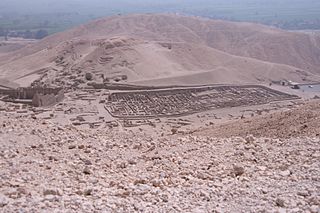
On this day in the year 1170 BCE, the first recorded strike took place against the building of pyramids in Egypt. It may be the first documented labor strike in history.
The action occurred at Deir el-Medina, an ancient Egyptian village which was home to the artisans who worked on the tombs in the Valley of the Kings during the 18th to 20th dynasties of the New Kingdom period, ca. 1550-1080 BCE. The settlement’s ancient name was Set Maat (The Place of Truth). During the Christian era the temple of Hathor was converted into a church from which the Arabic name Deir el-Medina (“the monastery of the town”) is derived.
From 1922-51 a team led by Bernard Bruyère began to excavate the site. Jaroslav Černý, who was on Bruyère’s team, went on to study the village for almost fifty years until his death in 1970 and was able to name and describe the lives of many of the inhabitants.This work has resulted in one of the most thoroughly documented accounts of community life in the ancient world that spans almost four hundred years. There is no comparable site in which the organization, social interactions, working and living conditions of a community can be studied in such detail.
The site is located on the west bank of the Nile, across the river from modern-day Luxor. The village is laid out in a small natural amphitheater, within easy walking distance of the Valley of the Kings to the north, funerary temples to the east and south-east, with the Valley of the Queens to the west. The village may have been built apart from the wider population in order to preserve secrecy in view of the sensitive nature of the work carried out in the tombs.
Surviving texts record the events of daily life. Personal letters reveal much about the economy, social relations and family life of the villagers.The settlement was home to a mixed population of Egyptians, Nubians and Asiatics who were employed as laborers (stone-cutters, plasterers, water-carriers), as well as those involved in the administration and decoration of the royal tombs and temples.The artisans and the village were organized into two groups, left and right gangs who worked on opposite sides of the tomb walls similar to a ship’s crew, with a foreman for each who supervised the village and its work.
As the main well was thirty minutes walk from the village, carriers worked to keep the village regularly supplied with water. When working on the tombs the artisans stayed overnight in a camp that is still visible today. The workers had cooked meals delivered to them from the village.
Based on analysis of income and prices, the workmen of the village would, in modern terms, be considered middle class. As salaried state employees they were paid in rations at up to three times the rate of a fieldhand, but they often held unofficial second jobs as well. The working week was eight days followed by two days holiday, though the six days off a month could be supplemented frequently due to illness, family reasons and, as recorded by the scribe of the tomb, arguing with your wife or having a hangover.
During their days off the workmen could work on their own tombs, and since they were among the best craftsmen in ancient Egypt who excavated and decorated royal tombs, their own tombs are considered to be some of the most beautiful on the west bank.A large proportion of the community, including women, could at least read and possibly write.
The workers and their families were not slaves but free citizens with recourse to the justice system as required. In principle any Egyptian could petition the vizier and could demand a trial by his peers. The community had its own court of law made up of a foreman, deputies, craftsmen and a court scribe, and were authorized to deal with all civil and some criminal cases, typically relating to the non-payment of goods or services.
The royal building service was usually well run in view of the importance of the work it carried out. Paying proper wages was a religious duty that, if abused, indicated problems in the wider state. The coming of the Iron Age and collapse of empire led to economic instability with inflation a notable feature. The high ideals expressed in the longstanding legal code became strained andprovided the background to worker unrest.
In about the 25th year of the reign of Ramses III, in 1170 BCE, the laborers were so exasperated by delays in supplies they threw down their tools and walked off the job in what comes down to us as the first sit-down strike in recorded history. They wrote a letter to the vizier complaining about lack of wheat rations. Village leaders attempted to reason with them but they refused to return to work until their grievances were addressed. They responded to the elders with “great oaths.””We are hungry,” the crews claimed:”Eighteen days have passed this month” and they still had not received their rations. They were forced to buy their own wheat.
After the authorities had heard their complaints they addressed them and the workers went back to work the next day. Several strikes followed as conditions in the village became increasingly unsettled. At times there was no work for fear of enemies. The grain supplies became less dependable. In order to make ends meet, a tomb-robbing culture developed that included fences and even some officials who accepted bribes. Gangs of tomb robbers often tunneled in through the back so they wouldn’t break the seal and be exposed. Further complaints by the artisans are recorded forty and fifty years after the initial dispute, during the reigns of Ramses IX and Ramses X.
The French Egyptologist and author Christian Jacq wrote a tetralogy dealing with Deir el-Medina and its artisans, as well as Egyptian political life at the time.
Adapted from Wikipedia.
Photo: Ruins of Deir el-Medina, a UNESCO World Heritage Site.










